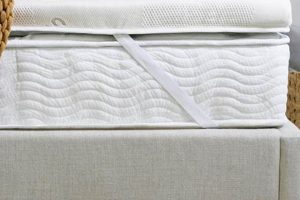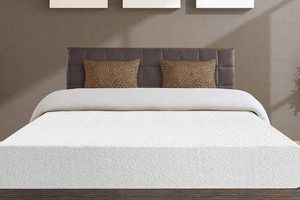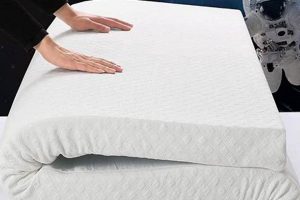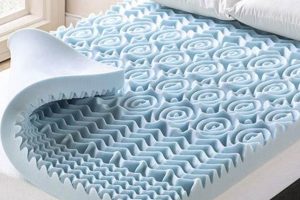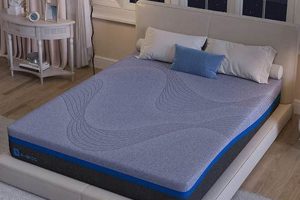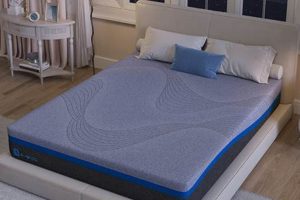A sleep surface designed for individual use, constructed with a viscoelastic foam layer, conforms to the body’s shape. This type of mattress provides targeted support and pressure relief for one sleeper. Its dimensions are typically around 36 inches wide and 75 inches long.
These sleep solutions offer enhanced comfort through their contouring properties, potentially improving sleep quality by minimizing pressure points. The material’s ability to distribute weight evenly contributes to spinal alignment and reduced tossing and turning. The technology has evolved from NASA research into temperature-sensitive materials and has become a widely adopted component in modern bedding for its comfortable and supportive characteristics.
The following sections will delve into specific aspects such as the composition and properties of the foam, factors to consider when selecting one, and the advantages it presents over other types of mattresses. This will provide comprehensive information for making an informed purchasing decision.
Selecting a Viscoelastic Single Bedding Surface
Careful consideration of several factors is crucial when choosing a viscoelastic single bedding surface. The objective is to optimize sleep quality and ensure long-term satisfaction with the purchase.
Tip 1: Density Assessment: Examine the foam density. Higher density foams generally offer greater support and durability. A density of 4 to 5 pounds per cubic foot is often considered ideal for a balance of comfort and longevity.
Tip 2: Thickness Evaluation: Evaluate the thickness of the viscoelastic layer. A thicker layer, typically 2-4 inches, provides enhanced contouring and pressure relief. Consider personal preferences for firmness and support when determining the optimal thickness.
Tip 3: Firmness Level: Assess the firmness level based on preferred sleeping position and body weight. Side sleepers may benefit from a softer surface, while back and stomach sleepers often require a firmer level of support. Test different firmness options to determine the most comfortable choice.
Tip 4: Heat Regulation: Consider the foam’s heat regulation properties. Viscoelastic material can retain heat; therefore, look for options with cooling technologies such as gel infusions or open-cell structures to promote airflow and prevent overheating.
Tip 5: Support Core: Analyze the support core beneath the foam layer. A high-density foam or innerspring core provides stability and prevents sagging. Ensure the support core is durable and well-constructed to extend the mattress’s lifespan.
Tip 6: Trial Period and Warranty: Prioritize purchasing from retailers offering a trial period and warranty. This allows for testing the mattress at home and provides protection against manufacturing defects or premature wear.
Tip 7: Certification Standards: Verify the mattress meets established certification standards, such as CertiPUR-US, which indicates the foam has been tested for harmful substances and emissions.
By adhering to these recommendations, one can make a well-informed decision when procuring a viscoelastic single bedding surface, thereby increasing the likelihood of achieving restful and restorative sleep.
The next section will address common misconceptions and maintenance practices related to viscoelastic mattresses.
1. Conforming support
Conforming support, a primary characteristic of a single memory foam mattress, arises from the material’s viscoelastic properties. This allows the mattress to mold to the sleeper’s body contours in response to weight and pressure. The effect is a reduction in pressure points, particularly at the shoulders, hips, and knees. For instance, a side sleeper on a traditional innerspring mattress may experience concentrated pressure on the shoulder and hip, potentially leading to discomfort or disrupted sleep. A single memory foam mattress, through its conforming ability, distributes the sleeper’s weight more evenly across the surface, alleviating these concentrated pressure points. This contributes to improved spinal alignment and reduced muscular strain during sleep.
The importance of conforming support in a single memory foam mattress lies in its direct influence on sleep quality and musculoskeletal health. Without this property, the mattress would function similarly to a rigid surface, failing to adapt to the sleeper’s unique body shape and weight distribution. Individuals with pre-existing conditions such as arthritis or back pain often find significant relief from the conforming support offered by this mattress type, as it minimizes stress on sensitive joints and muscles. Furthermore, the enhanced weight distribution minimizes the likelihood of developing new pressure sores, an important consideration for individuals with limited mobility.
In summary, the conforming support provided by a single memory foam mattress is not merely a comfort feature but a functional attribute that directly impacts sleep quality, spinal alignment, and pressure distribution. Understanding this connection allows consumers to make informed decisions based on their individual needs and physical conditions, selecting a mattress that promotes restful and restorative sleep while mitigating potential musculoskeletal discomfort. The challenge lies in discerning the optimal density and thickness of the foam to achieve the desired level of conforming support, a consideration that often necessitates personal testing and evaluation.
2. Pressure Relief
Pressure relief is a crucial attribute of a single memory foam mattress, contributing significantly to sleep quality and overall comfort. Its ability to minimize concentrated stress on specific body parts distinguishes it from traditional innerspring designs.
- Weight Distribution
Memory foam’s viscoelastic nature allows it to conform closely to the body’s shape. This distributes weight more evenly across the mattress surface, reducing pressure on prominent areas such as the shoulders, hips, and knees. Traditional mattresses often create pressure points due to their uniform support, leading to discomfort. Consider a 150-pound individual; on a standard mattress, much of that weight is borne by a few concentrated areas, whereas a memory foam mattress disperses it over a larger surface.
- Spinal Alignment
By contouring to the body’s natural curves, memory foam can promote proper spinal alignment, particularly for side sleepers. A misaligned spine can contribute to back pain and muscle stiffness. A single memory foam mattress, by filling the gaps between the mattress and the body, offers support that helps maintain the spine’s natural curvature, thereby mitigating potential discomfort.
- Reduced Tossing and Turning
The pressure-relieving properties of memory foam can
lead to a reduction in tossing and turning during sleep. Discomfort caused by pressure points often prompts individuals to shift positions throughout the night. By minimizing these pressure points, a memory foam mattress may enable a more restful and undisturbed sleep cycle. - Enhanced Circulation
Reduced pressure on bony prominences can improve blood circulation. Prolonged pressure can restrict blood flow, contributing to discomfort and potentially leading to pressure sores in individuals with limited mobility. A memory foam mattress, by alleviating these concentrated pressure zones, can promote better circulation throughout the night.
The aggregate effect of these facets underscores the significance of pressure relief in a single memory foam mattress. It directly influences comfort, spinal health, sleep quality, and overall well-being. The ability of the mattress to conform to the individual’s body shape, distribute weight evenly, and minimize pressure points distinguishes it as a potentially beneficial sleep surface, particularly for those with pre-existing pain conditions or circulatory issues.
3. Motion Isolation
Motion isolation, a significant advantage of single memory foam mattresses, refers to the ability of the mattress to absorb movement, preventing it from transferring across the surface. This feature is particularly valuable for individuals who share a bed with a partner or pet, as it minimizes sleep disturbances caused by their movements.
- Viscoelastic Properties
Memory foam’s unique viscoelastic properties contribute directly to its motion isolation capabilities. The material’s dense, cellular structure absorbs energy rather than transmitting it. When pressure is applied to one area of the mattress, the foam compresses locally, limiting the spread of movement to other areas. This contrasts with traditional innerspring mattresses, where interconnected coils can amplify and transmit motion across the entire surface. For example, if one individual gets out of bed, the disturbance is significantly less noticeable on a memory foam mattress compared to an innerspring model.
- Density and Thickness
The density and thickness of the memory foam layer influence the degree of motion isolation. Higher density foams generally provide superior motion absorption compared to lower density foams. Similarly, a thicker layer of memory foam can better dampen movement. A mattress with a high-density, thick memory foam layer effectively minimizes the transmission of motion caused by activities such as tossing, turning, or getting in and out of bed.
- Construction and Layering
The overall construction of the single memory foam mattress, including the presence of additional support layers, impacts motion isolation. Mattresses with multiple layers of different foam densities can provide enhanced motion absorption. For instance, a mattress may incorporate a high-density base layer for support, a medium-density transition layer, and a top layer of conforming memory foam, each contributing to the reduction of motion transfer. The strategic combination of layers effectively dampens movement throughout the mattress.
- Comparison to Other Mattress Types
Compared to other mattress types, such as innerspring or hybrid models, single memory foam mattresses generally offer superior motion isolation. Innerspring mattresses, with their interconnected coil systems, tend to transmit movement more readily. Hybrid mattresses, which combine innerspring coils with foam layers, may offer some degree of motion isolation, but typically not to the same extent as a dedicated memory foam mattress. The inherent properties of memory foam make it particularly well-suited for minimizing sleep disturbances caused by motion.
The combination of viscoelastic properties, density, thickness, and overall construction contributes to the exceptional motion isolation offered by a single memory foam mattress. This attribute is critical for individuals seeking uninterrupted sleep, particularly those who share a bed or are easily awakened by movement. The ability of the mattress to absorb and dampen motion provides a significant advantage over other mattress types, promoting a more restful and undisturbed sleep experience.
4. Density options
Density, measured in pounds per cubic foot (PCF), is a critical factor influencing the performance and longevity of a single memory foam mattress. The density of the memory foam core directly affects its support characteristics, durability, and ability to conform to the sleeper’s body. Lower-density foams (typically below 3 PCF) offer a softer feel and quicker recovery but tend to degrade more rapidly, resulting in reduced support over time. These are often used in comfort layers but are less suitable as a primary support component. Conversely, higher-density foams (4 PCF and above) provide firmer support, greater resistance to compression, and extended durability. These are preferred for individuals requiring substantial support, such as those with back pain or higher body weight. A real-life example is a person weighing over 200 pounds; a mattress with a low-density foam core would likely sag prematurely, leading to discomfort and inadequate support, whereas a high-density core would maintain its structure and provide consistent support for a longer period. The practical significance lies in understanding that density directly correlates with the mattress’s ability to maintain its shape and provide consistent support over years of use.
The choice of density also impacts the mattress’s temperature regulation properties. Higher-density foams, while offering enhanced support, tend to retain more heat due to their denser structure, limiting airflow. This can be a concern for individuals who sleep hot. Manufacturers often address this issue by incorporating cooling technologies such as gel infusions or open-cell structures into the memory foam. Therefore, selecting a density requires balancing support needs with potential heat retention. Furthermore, density influences the mattress’s responsiveness. Lower-density foams tend to respond more quickly to changes in pressure, providing a more immediate conforming feel. Higher-density foams may exhibit a slower response time, resulting in a slightly firmer initial feel. The practical application of this understanding involves considering individual preferences for feel and responsiveness when selecting a mattress density. For instance, an individual who prefers a cradling sensation might opt for a medium-density foam, while someone prioritizing firm support might choose a higher-density option.
In conclusion, density options are not merely a technical specification but a fundamental determinant of a single memory foam mattress’s overall performance. The interplay between density, support, durability, temperature regulation, and responsiveness dictates the suitability of a particular mattress for an individual’s specific needs. The challenge lies in navigating the trade-offs associated with different densities to find the optimal balance. A thorough understanding of these factors is crucial for making an informed purchasing decision, ensuring long-term satisfaction, and maximizing the health benefits associated with proper sleep support. Ignoring density considerations can lead to premature mattress degradation, inadequate support, and ultimatel
y, a compromised sleep experience.
5. Heat retention
Heat retention is a notable characteristic of single memory foam mattresses, stemming from the material’s inherent properties. The dense, closed-cell structure of traditional memory foam restricts airflow, impeding the dissipation of body heat. This can result in a warmer sleep environment compared to mattresses constructed with more breathable materials. The degree of heat retention varies depending on the density of the foam and the specific manufacturing process. Higher-density foams tend to retain more heat due to their increased cellular packing. An individual residing in a warmer climate may experience exacerbated heat retention, leading to discomfort and potential sleep disturbances. The practical significance of understanding this lies in the ability to proactively address potential thermal discomfort through informed mattress selection.
To mitigate heat retention, manufacturers employ various strategies. Gel infusions, for example, introduce phase-changing materials designed to absorb and release heat, thereby moderating the mattress’s surface temperature. Open-cell foam structures, characterized by interconnected air pockets, enhance airflow, facilitating the removal of heat. Other approaches include the use of breathable covers made from materials like Tencel or bamboo, which promote moisture wicking and ventilation. The effectiveness of these strategies varies depending on their implementation and the individual’s physiology and environmental conditions. For example, a gel-infused memory foam mattress may provide noticeable cooling for some individuals but may not be sufficient for those who naturally sleep hot. Practical application of this knowledge involves carefully considering the specific cooling technologies employed in a mattress and assessing its suitability based on personal needs and environmental factors.
In summary, heat retention is a critical consideration when evaluating single memory foam mattresses. The inherent thermal properties of memory foam necessitate proactive measures to manage heat and ensure a comfortable sleep environment. While cooling technologies offer potential solutions, their effectiveness varies. The challenge lies in selecting a mattress that effectively balances the benefits of memory foam, such as pressure relief and motion isolation, with the need for adequate temperature regulation. A thorough understanding of these factors is crucial for optimizing sleep quality and overall satisfaction with a memory foam mattress purchase.
6. Size specifications
Accurate size specifications are paramount when considering a single memory foam mattress purchase. Compatibility with existing bed frames, room dimensions, and individual sleeper needs hinge directly on adherence to standardized measurements. Failure to account for size specifications can lead to an incompatible setup, rendering the mattress unusable or compromising sleep quality.
- Standard Dimensions
A standard single memory foam mattress typically measures approximately 39 inches in width and 75 inches in length. These dimensions are designed to fit within a standard single bed frame. Variations, though uncommon, may exist between manufacturers. For example, a European single mattress may have different dimensions, requiring a corresponding bed frame. Adherence to these dimensions ensures proper fit, prevents mattress overhang or slippage, and contributes to the overall stability of the sleep setup.
- Frame Compatibility
Prior to purchasing a single memory foam mattress, verifying compatibility with the intended bed frame is essential. Bed frames are designed to accommodate specific mattress sizes. A mismatch can result in inadequate support, premature wear and tear on the mattress, or potential safety hazards. A platform bed, for instance, requires a mattress that precisely fits within its boundaries. Conversely, a slatted frame necessitates proper spacing between slats to provide adequate support and prevent sagging.
- Room Dimensions
Room size dictates the feasibility of accommodating a single memory foam mattress and its associated bed frame. Overcrowding can restrict movement, impede access to other furniture, and create a claustrophobic environment. Measuring the available space and considering the dimensions of other room furnishings is crucial to ensure a comfortable and functional living space. A small bedroom may necessitate a minimalist setup to maximize available space, while a larger room offers greater flexibility in terms of bed frame selection and overall room layout.
- Sleeper Requirements
While a single memory foam mattress is designed for individual use, sleeper size and movement patterns should be considered. Individuals who are taller or tend to move extensively during sleep may benefit from exploring alternative mattress sizes or configurations. A larger mattress, such as a twin XL, provides additional length for taller individuals, while a wider mattress offers greater freedom of movement. However, these options may not be suitable for smaller rooms or individuals with limited space.
These size specifications represent integral components of the selection process for a single memory foam mattress. The implications of neglecting these factors range from incompatibility with existing infrastructure to compromised sleep quality and overall discomfort. Meticulous attention to size specifications ensures a harmonious integration of the mattress within the intended environment, maximizing its benefits and contributing to a restful sleep experience.
7. Lifespan expectancy
The lifespan expectancy of a single memory foam mattress is a critical consideration that directly impacts its value proposition. This metric, typically ranging from 7 to 10 years under normal usage conditions, is influenced by several factors, including foam density, material quality, construction techniques, and user weight. Lower density foams degrade more rapidly under consistent pressure, resulting in diminished support and the development of indentations. A higher-density foam, while more expensive, exhibits greater resistance to compression and prolongs the mattress’s useful life. For example, a mattress with a 2.5 PCF (pounds per cubic foot) foam core may only provide adequate support for 5 years, whereas a 5 PCF core could maintain its structural integrity for a decade or longer. The practical significance lies in the long-term cost-effectiveness; investing in a higher-quality, longer-lasting mattress can mitigate the need for frequent replacements, ultimately saving money.
Proper maintenance practices significantly influence a single memory foam mattress’s lifespan. Regularly rotating the mattress, typically every 3 to 6 months, distributes wear evenly across the surface, preventing localized sagging. Using a protective mattress encasement safeguards against spills, stains, and allergens, minimizing the potential for material degradation. Avoidance of direct sunlight and excessive humidity prevents foam breakdown and mold growth. Moreover, adhering to the manufacturer’s weight recommendations is crucial to preve
nt undue stress on the mattress’s internal components. Consider a scenario where a user significantly exceeds the recommended weight limit; this accelerates compression and diminishes the mattress’s ability to provide adequate support, effectively shortening its lifespan. These practices collectively contribute to preserving the mattress’s structural integrity and prolonging its useful life.
The inherent challenge in assessing lifespan expectancy lies in predicting individual usage patterns and environmental factors. While manufacturers provide general guidelines, actual lifespan varies considerably depending on these variables. A single individual of average weight who diligently maintains their mattress can reasonably expect it to last closer to the upper end of the lifespan range. Conversely, a heavier individual who neglects proper maintenance may experience a significantly shorter lifespan. Therefore, while lifespan expectancy serves as a useful benchmark, it should be considered in conjunction with individual circumstances and maintenance habits. Ultimately, selecting a single memory foam mattress involves a trade-off between initial cost and anticipated longevity, requiring careful consideration of material quality, construction, and individual usage patterns to maximize its value.
Frequently Asked Questions
The following addresses common inquiries concerning single memory foam mattresses, offering factual information to aid informed decision-making.
Question 1: What is the typical density range for a single memory foam mattress, and how does it affect performance?
Density typically ranges from 2.5 to 5.5 pounds per cubic foot (PCF). Lower density foams (2.5 – 3.5 PCF) provide a softer feel but may lack long-term support. Higher density foams (4.0 – 5.5 PCF) offer increased support and durability, suitable for individuals requiring firmer support.
Question 2: How does a single memory foam mattress address heat retention concerns?
Manufacturers often integrate cooling technologies such as gel infusions, open-cell structures, or breathable covers (e.g., Tencel) to mitigate heat retention. These features promote airflow and regulate temperature.
Question 3: What are the advantages of motion isolation in a single memory foam mattress?
Motion isolation minimizes the transfer of movement across the mattress surface. This is particularly beneficial for light sleepers sharing a room, as it reduces disturbances caused by another individual’s movements.
Question 4: How frequently should a single memory foam mattress be rotated or flipped?
Rotating the mattress every 3-6 months promotes even wear and prevents localized sagging. Flipping is generally not recommended for mattresses with a designated top and bottom layer.
Question 5: What is the expected lifespan of a single memory foam mattress, and what factors influence it?
The lifespan typically ranges from 7 to 10 years, depending on foam density, material quality, user weight, and maintenance practices. Higher density foams and proper maintenance contribute to extended longevity.
Question 6: Are single memory foam mattresses suitable for individuals with back pain?
The conforming support and pressure relief offered by memory foam can alleviate back pain by promoting spinal alignment and reducing stress on pressure points. However, firmness preferences vary; individuals with back pain should select a firmness level that provides adequate support without excessive softness.
In summary, density, heat regulation, motion isolation, maintenance, lifespan, and suitability for specific needs are key considerations when evaluating a single memory foam mattress. These factors influence comfort, support, and long-term value.
The next section will provide guidance on selecting reputable brands and retailers.
Concluding Remarks on the Single Memory Foam Mattress
This exploration has addressed the core attributes of the single memory foam mattress, encompassing its conforming support, pressure relief capabilities, motion isolation properties, varying density options, potential for heat retention, standardized size specifications, and estimated lifespan. Understanding these facets is essential for making informed purchasing decisions.
The single memory foam mattress represents a significant advancement in sleep technology, offering potential benefits for individual sleepers. Careful consideration of personal needs and preferences, combined with a thorough understanding of the mattress’s characteristics, will maximize the likelihood of achieving restful and restorative sleep. The future of bedding may bring further innovations, yet the core principles of support, comfort, and durability remain paramount in selecting a sleep surface that promotes long-term health and well-being.


